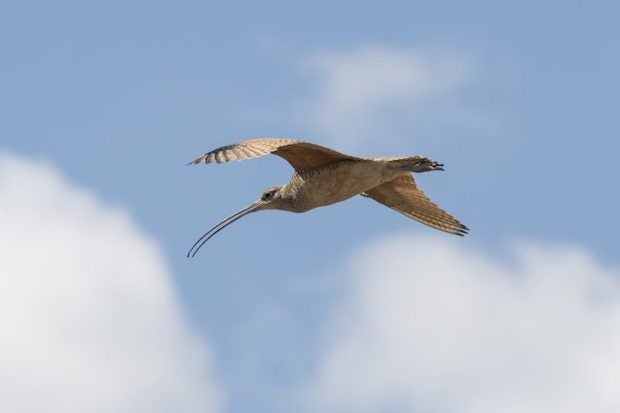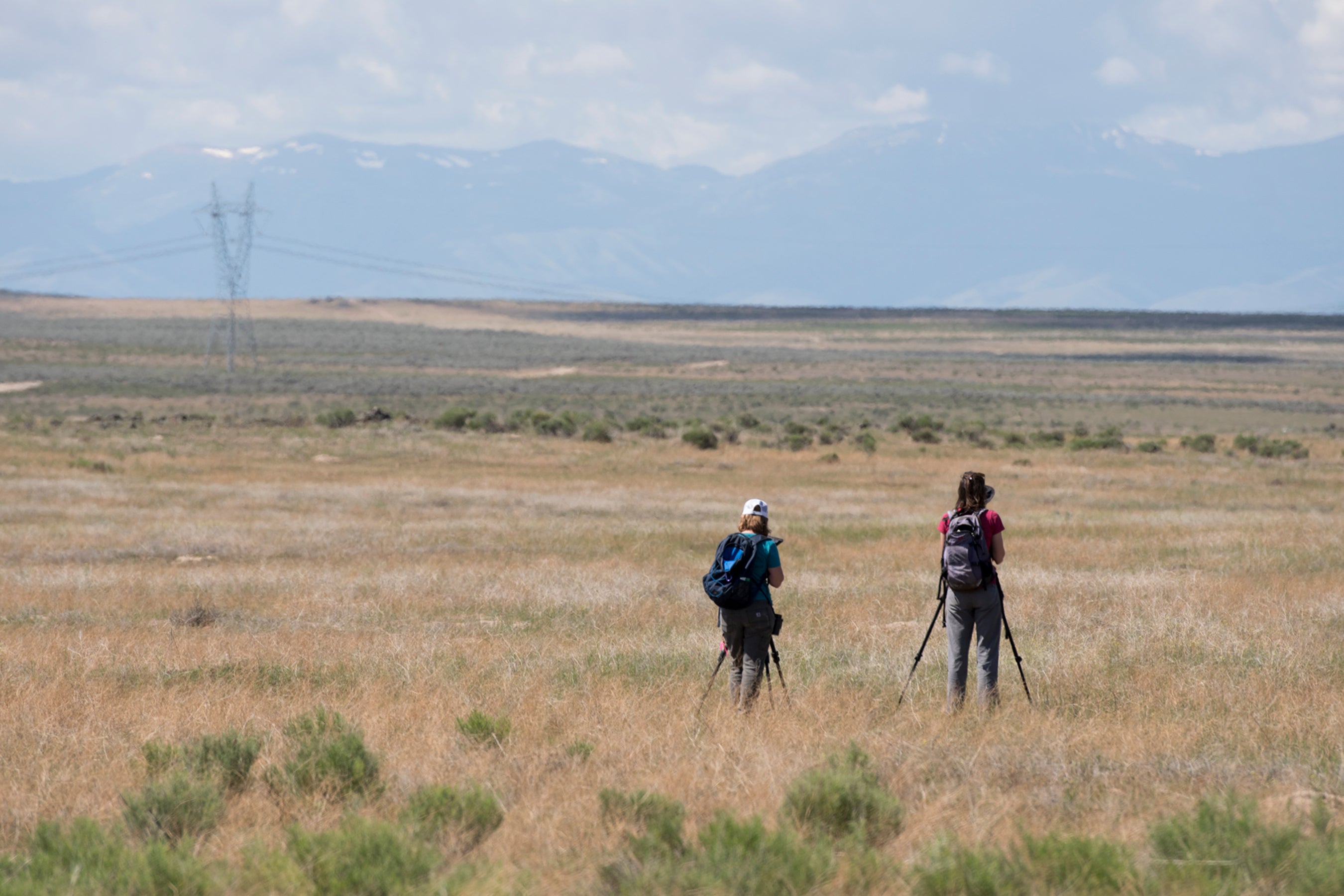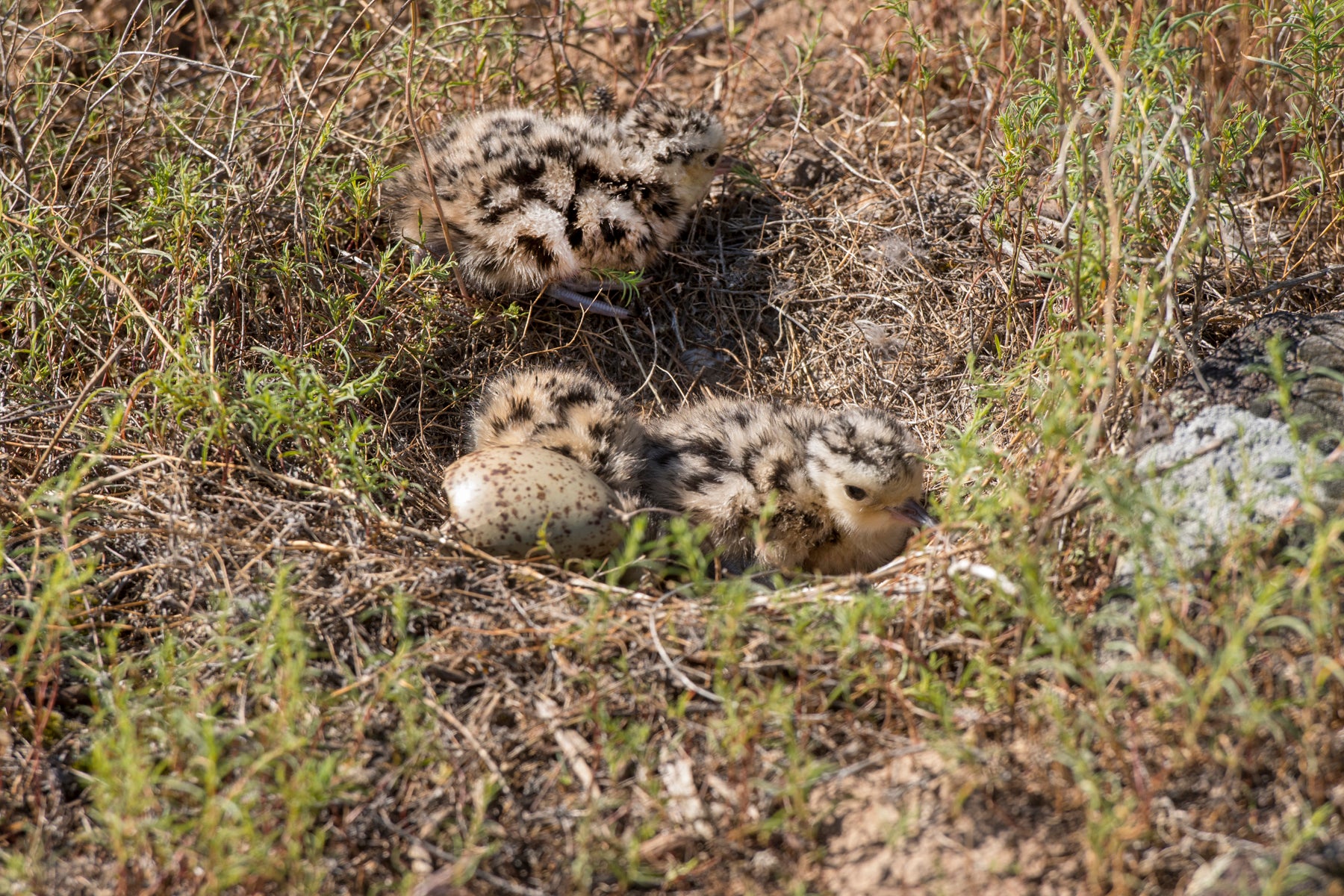
Long-billed curlew in flight in the skies over Idaho.
It’s fair to say the season has been bittersweet for the researchers at Boise State’s Intermountain Bird Observatory who study the long-billed curlew.
Poaching of the migratory birds continues to be a problem in Southern Idaho. It’s taking place in protected areas like the Morley Nelson Snake River Birds of Prey National Conservation Area in the desert south of Boise and the Long-billed Curlew Habitat Area of Critical Environmental Concern, grassland northwest of Middleton. Over the past two years, poachers have shot as many as 10 curlews in those areas, said Jay Carlisle, Intermountain Bird Observatory research director. That’s more birds shot than in any previous two-year period.
If anything positive came from the most recent poaching incident — the shooting this spring of a nesting female bird in the Area of Critical Environmental Concern — it’s that it attracted extensive coverage by local newspapers, television and radio. U.S. News and World Report, The Wildlife Society, Audubon magazine, and others wrote stories.
“No one was ignoring the poaching issue before. But a lot of people hadn’t realized its severity,” said Carlisle.

Curlew researchers Stephanie Coates and Joni Clapsadle
from the Intermountain Bird Observatory.
Killing a curlew is a misdemeanor, punishable by jail time and a $15,000 fine. Curlews are not listed as threatened nor endangered, but they are protected year-round by the Migratory Bird Treaty Act. Their populations are in decline and they are among more than 30 birds listed by Idaho Fish and Game as a Species of Greatest Conservation Need. In short, there is never a season for hunting curlews.
All the press coverage will aid IBO’s public education efforts to make more people aware of the bird, and of its protected status, said Carlisle.
“The goal,” he added, “is working with other agencies including Fish and Game, the BLM and the Idaho Army National Guard (whose training grounds are home to curlews) to sustain populations of curlews in this region, sharing what we’ve already learned through a decade of research and what the threats are.”
The number one threat, he said, is illegal shooting.
Zoe Tinkle, a biologist in the National Guard’s Environmental Management Office, received both her undergraduate and graduate degrees at Boise State. She is working with the IBO to monitor curlew populations. It’s often a surprise, she said, when people learn that the land where the Guard has trained for more than 60 years lies within the Morley Nelson conservation area. Part of Tinkle’s job is making sure any training activities there are compatible with wildlife. She dispels an assumption she hears a lot — that curlews have been shot by accident during military exercises. No live-fire training takes place near the curlew nesting grounds. The area is, however, a popular spot for hunting ground squirrels. Tinkle suspects many of the poached curlews were killed — whether on purpose or unintentionally — by those shooters.
“If we study what’s happening with curlews, we will get a bigger picture of what’s happening with public recreation and recreational shooting,” said Tinkle.

Ben Wright, a student with the Intermountain Bird Observatory, holds Cinder, one of the curlews researchers fitted with a tracking transmitter in 2018. The transmitter includes an antenna, visible in the photo. As of early August, according to the tracking device, Cinder was just north of Los Angeles.
This is especially important now, she added. Idaho’s rapid population growth means more people and animals sharing ever more crowded space. She worries, too, for the safety of soldiers in the area, many of whom are in camouflage and might not be visible to hunters.
“For the past four or five years we have collaborated with the IBO at Boise State because the researchers have such knowledge. The Guard is interested in joining them in any kind of public education that could help protect our natural resources, as well as our soldiers,” said Tinkle.
Research ongoing
Along with public outreach, the IBO will continue gathering data about the curlew, a bird notable for its distinct, arc-shaped beak. Male curlews “spar” at the beginning of nesting season to establish their territories, said Tinkle. Instead of fighting with their long beaks, as one might expect, they assert dominance by picking up dirt clods and throwing them at one another.
“I have to admit it’s one of the cutest, most hilarious things I’ve seen,” said Tinkle.
Male curlews also spend more time on the nest than females — between 14-15 hours a day, mostly overnight.
The breeding grounds of long-billed curlews include Southern Idaho and other parts of the Intermountain West and Midwest. The birds spend around three months in these regions beginning in the early spring, then depart for California or Mexico.
The IBO is in its 6th season of using satellite transmitters to track the birds through this cycle.

Curlew chicks in the nest in Idaho. Curlews nest on the ground.
Thanks to the support of more than 20 partners across three states, IBO researchers have been able to outfit 72 birds with the transmitters, each of which costs more than $3,000. The transmitters are the size of a nine-volt battery, but weigh no more than two quarters. They sit on the bird’s lower hips, not unlike a fanny pack, said Carlisle. The transmitters chart travel paths, the movements and behaviors of birds in different habitats, and more.
The study has a built-in public relations component. Anyone can track the curlews — many with Idaho-centric names like Emmett, Syringa, and Bethine — through the “CurlewView” website. A recent check found birds scattered between San Francisco and as far south as San Luis Potosi, Mexico.
Carlisle is looking forward to the spring of 2019 when the birds will return. He and other researchers are strategizing about how to keep them safer than they have been in past seasons.
“My hope is that we’ll be able to work with local media as successfully as we have this year, and share more positive facts about curlews, and let people know, ‘Hey, the curlews are back,’” he said.
BY: ANNA WEBB PUBLISHED 6:50 AM / AUGUST 8, 2018